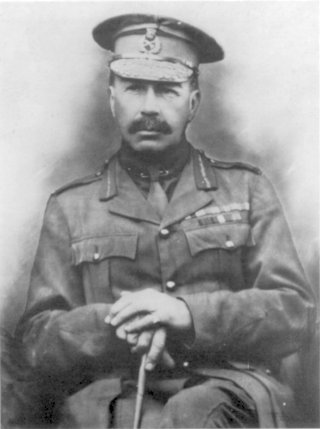

 The South African
The South African
‘Tim’ Lukin was born at Fulham, London on 24 May 1860 and was educated at Merchant Taylor’s School.

He came out to South Africa in 1879 to begin his military career with a commission in Bengough’s Horse, a native mounted corps raised for service in the Zulu War of that year. He was severely wounded at the battle of Ulundi in July 1879.
In March 1881 Lukin joined the Cape Mounted Riflemen (CMR) and took part in the operations in Basutoland during that year and thus earned the Cape of Good Hope General Service Medal, with bar ‘Basutoland’.
In 1891, while stationed in Alice, he married Lily Quinn.
In 1893 he attended courses in gunnery and military signalling at Shoeburyness, Woolwich, Aldershot and Hythe and on his return to South Africa in 1894 was appointed to command the CMR Artillery Troop and also as instructor in signalling. In 1897 he was promoted Captain.
During the Langeberg Campaign of 1896-7 he commanded the Maxim guns and signalling section and served as Field Adjutant of the Bechuanaland Field Force which earned him the bar ‘Bechuanaland’ to his Cape of Good Hope General Service Medal.
The outbreak of the South African War in 1899 saw Lukin on active service once more with the CMR and in November 1900 he was promoted to the rank of Lieutenant-Colonel. For his leadership during the Siege of Wepener he was awarded the Distinguished Service Order, and a few months later was made a Companion of the Order of St Michael and St George. Lukin’s promotion to the rank of Colonel on 1 January 1903, when he succeeded Colonel E.H. Dalgety as Commanding Officer of the Cape Mounted Riflemen, always remained, for him, a source of great personal pride. In 1904, whilst retaining command of the CMR, he was also appointed Inspector-General, Cape Colonial Forces, a post in which he worked with untiring devotion, building the Cape Forces into a highly-trained and disciplined body of men, laying bare incompetence, encouraging his officers to attend courses, and urging the formation of Cadet Corps at schools in the Cape.
His King George V Coronation Medal was earned when he commanded the Union of South Africa contingent at the Coronation in 1911.
He next proceeded to Switzerland to study the Swiss military system.
On the formation of the Permanent Force, Union Defence Forces, in terms of the South African Defence Act of 1912, Lukin was appointed Inspector-General with the rank of Brigadier-General.
On the outbreak of World War I, Lukin was given command of the South African Mounted Riflemen Column and subsequently the S.A.M.R. Brigade in German South-West Africa, during the Campaign of 1914-1915.
In December 1915 Lukin left for Alexandria, North Africa, with the 1st South Africa Infantry Brigade where, as Brigade Commander, he led his men successfully against the Senussite army at the Battle of Agagia, and then went on to take Sollum. His services in Egypt were rewarded with the Companionship of the Order of the Bath, and the Khedive appointed him to the Egyptian Order of the Nile.
The Brigade arrived at Marseilles, France, in April 1916. Its war record on the Western Front appears proudly in the annals of World War I and the Brigade will long be remembered for such battles as Delville Wood and Butte de Warlencourt.
From Brigade Commander he rose to the rank of Major-General commanding the 9th (Scottish) Division at Arras, Passchendaele and Cambrai during 1917 and in the New Year’s Honours List of that year he was appointed a Knight Commander of the Order of the Bath.
He had to return to England because of Lady Lukin’s ill-health but in March 1918 he returned to duty as Commander of the 64th (Highland) Division.
He retired in 1919 with the rank of Major-General and the award by the French Government of the Legion of Honour (Commander).
He died on 15 December 1925 and was buried with full military honours at Plumstead Cemetery, Cape Province.
REFERENCES
Buchan, John The history of the South African Forces in France. Cape Town, Maskew Miller, 1921.
Ewing, John The history of the 9th (Scottish,) Division 1914-1919. London, John Murray, 1921.
Johnson, RE. Ulundi to Delville Wood: the life story of Major-General Sir
Henry Timson Lukin. Cape Town, Maskew Miller, n.d.
Lorch, A.E. The story of the Cape Mounted Riflemen, 1st Aug 1878-31st
March 1913, and 1st Regiment South African Mounted Riflemen, 1st
April 1913-1st April 1926. Pretoria, V and R Printers, n.d.
Union of South Africa Defence Dept. The Union of South Africa and the
Great War 1914-1918: Official History, Pretoria, Govt. Printer, 1924.
Williams, Basil Record of the Cape Mounted Riflemen. London, Joseph
Caustron, 1909.
Young, P.J. Boot and saddle: a narrative record of the Cape Regiment, the
British Cape Mounted Riflemen, the Frontier Armed Mounted Police
and the Colonial Cape Mounted Riflemen. Cape Town, Maskew Miller, 1955.
Return to Journal Index OR Society's Home page
South African Military History Society / scribe@samilitaryhistory.org